BUICK RIVIERA 1993 User Guide
Manufacturer: BUICK, Model Year: 1993, Model line: RIVIERA, Model: BUICK RIVIERA 1993Pages: 324, PDF Size: 16.01 MB
Page 11 of 324
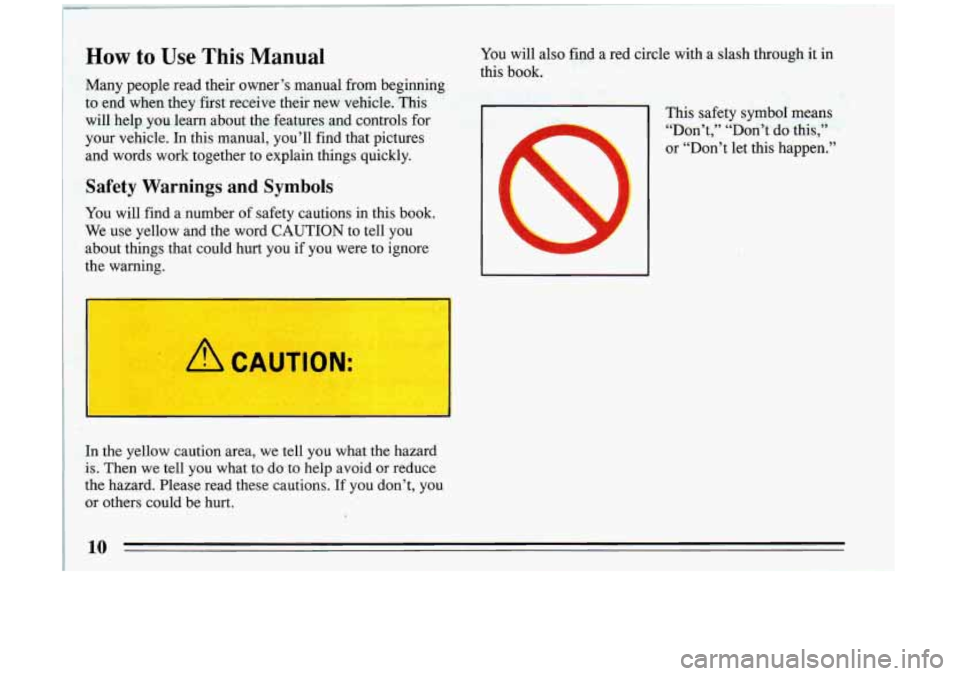
How to Use This Manual You will also find a red circle with a slash through it in
Many people read their owner’s manual from beginning
to end when they first receive their new vehicle. This
will help you learn about the features and controls for
your vehicle. In this manual, you’ll find that pictures
and words work together to explain things quickly.
Safety Warnings and Symbols
You will find a number of safety cautions in this book.
We use yellow and the word CAUTION to tell you
about things that could hurt you if you were to ignore
the warning. this book.
I This safety symbol means
“Don’t,’’ “Don’t do
this,”
or “Don’t let this happen.”
In the yellow caution area, we tell you what the hazard
is. Then we tell
you what to do to help avoid or reduce
the hazard. Please read these cautions. If you don’t, you
or others could be
hurt.
10
Page 12 of 324
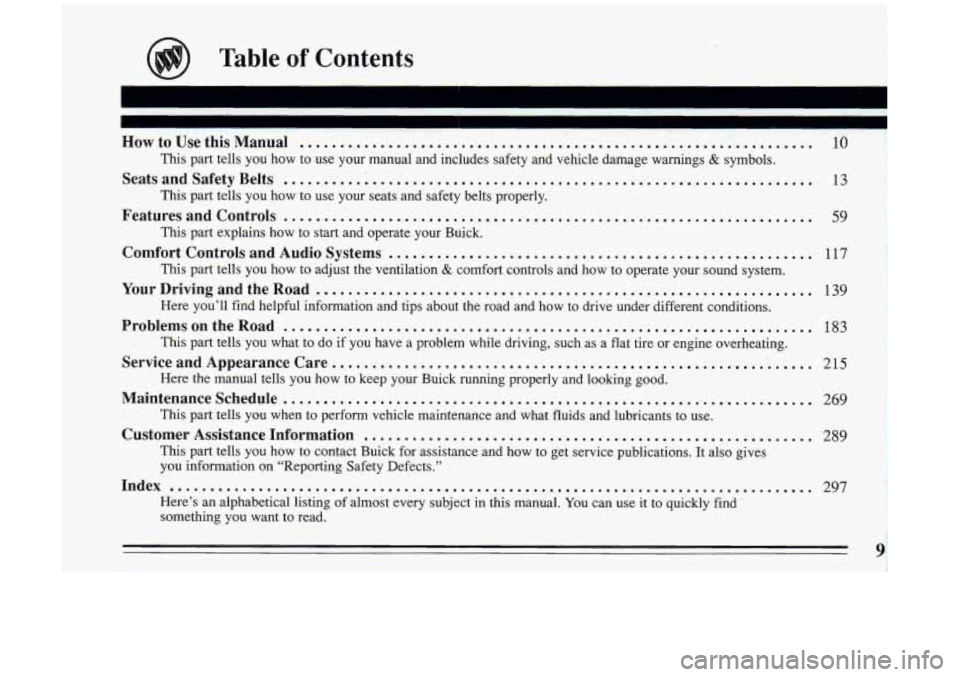
HowtoUsethisManual ................................................................
This part tells you how to use your manual and includes safety and vehicle damage warnings & symbols.
SeatsandSafetyBelts ..................................................................
This part tells you how to use your seats and safety belts properly.
Featuresandcontrols ..................................................................
This part explains how to start and operate your Buick.
This part tells you how to adjust the ventilation
& comfort controls and how to operate your sound system.
YourDrivingandtheRoad ..............................................................
Here you’ll find helpful information and tips about the road and how to drive under different conditions.
ProblemsontheRoad ..................................................................
This part tells you what to do if you have a problem while driving, such as a flat tire or engine overheating.
ServiceandAppearanceCare ............................................................
Here the manual tells you how to keep your Buick running properly and looking good.
Maintenanceschedule ..................................................................
This part tells you when to perform vehicle maintenance and what fluids and lubrica\
nts to use.
Customer Assistance Information ........................................................
This part tells you how to contact Buick for assistance and how to get service publications. It also gives
you information on “Reporting Safety Defects.”
Index ........................................................................\
........
Here’s an alphabetical listing of almost every subject in this manual. You can use it to quickly find
something
you want to read.
Comfort Controls and Audio Systems .....................................................
10
13
59
117
139
183
215
269
289
297
Page 13 of 324
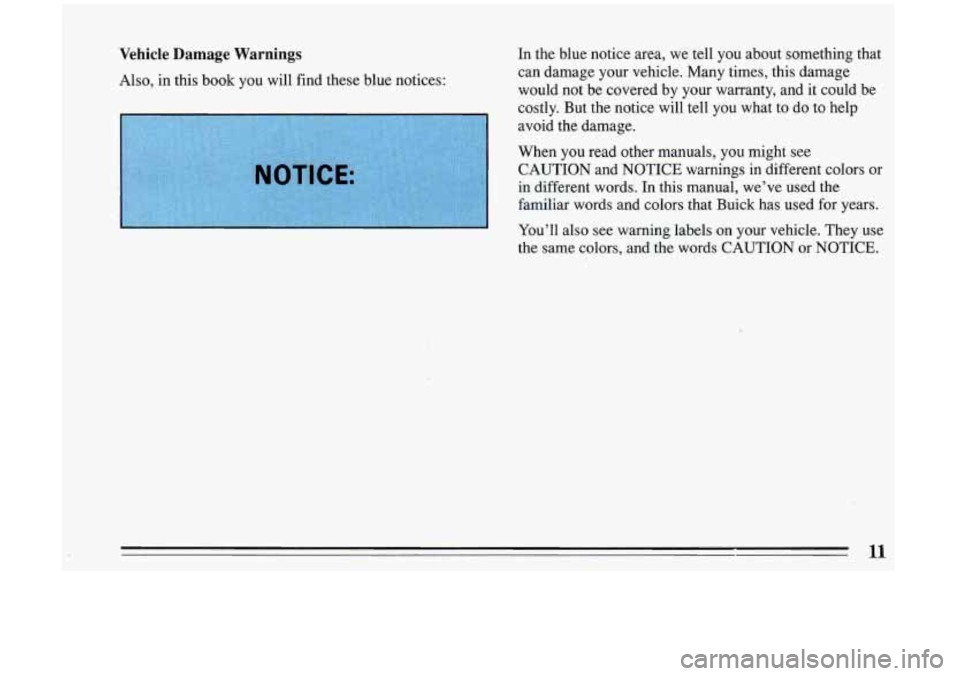
Vehicle Damage Warnings
Also, in this book you will find these blue notices: In
the blue notice area, we tell you about something that
can damage your vehicle. Many times, this damage
would not be covered by your warranty, and it could be
0 costly. But the notice will tell you what to do to help
avoid the damage.
When you read other manuals, you might see
CAUTION and NOTICE warnings in different colors or
in different words,. In this manual, we've used the
familiar words and colors that Buick has used for years.
"
You'll also see warning labels on your vehicle. They use
the same colors, and the words CAUTION or NOTICE.
11
Page 14 of 324
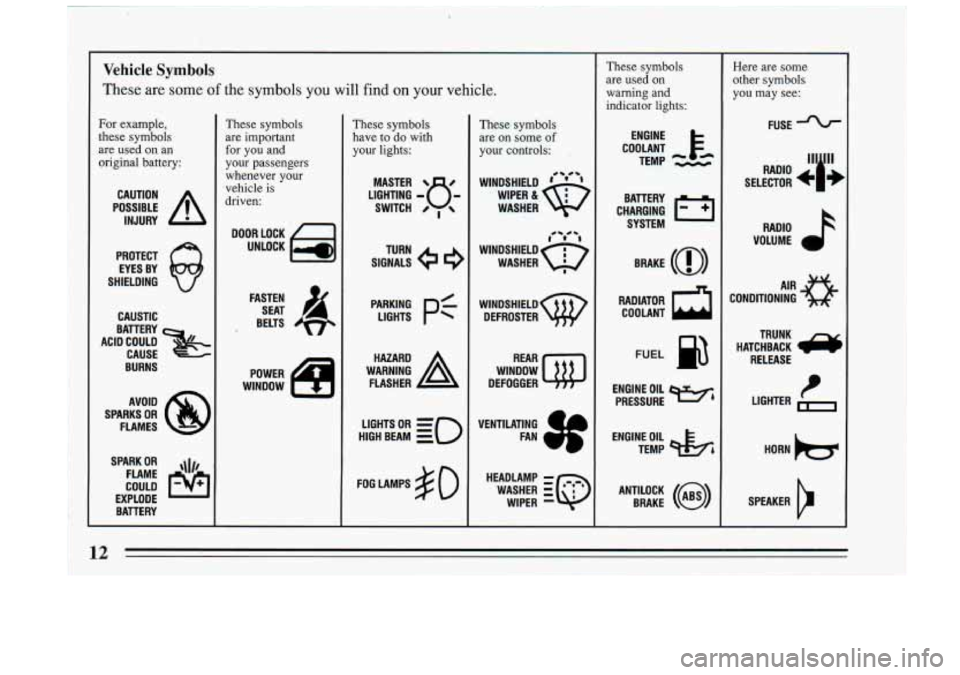
Vehicle Symbols
These are some of the symbols you will find on your vehicle.
For example,
these symbols
are used on an
original battery:
POSSIBLE A
CAUTION
INJURY
PROTECT EYES BY
SHIELDING
CAUSTIC
BURNS AVOID
SPARKS
OR
FLAMES
SPARK
OR ,111,
COULD pq
FLAME
EXPLODE BATTERY
These symbols
are important
for you and
your passengers whenever your
vehicle
is
driven:
FASTEN SEAT 4
BELTS
These symbols
have to do with
your lights:
SIGNALS TURN
HIGH BEAM
OR = =o
FOG LAMPS $0
These symbols
are on some
of
your controls:
WINDSHIELD ’ ’ ’ 4- #-
WASHER
f0 -**
WINDSHIELD Q
WASHER I
WINDSHIELD
DEFROSTER
WINDOW
DEFOGGER
VENTILATING
FAN
L.
HEADLAMP - ,~*-,
WASHER iQ
WIPER -
L
These symbols
are used on
warning and
indicator lights:
COOLANT F-
TEMP --
ENGINE
CHARGING
I-1
BATTERY SYSTEM
RADIATOR
a
COOLANT
FUEL
ENGINE OIL
PRESSURE
Wb
TEMP OIL &
ANTILOCK (@)
BRAKE
Here are some
other symbols
you may see:
FUSE
RADIO
‘‘ill
SELECTOR
RADIO
k
VOLUME
CONDITIONING
AIR 33
HATCHBACK /y
TRUNK
RELEASE
t LIGHTER 1-
HORN
SPEAKER
cr
~ 12 , .
Page 15 of 324
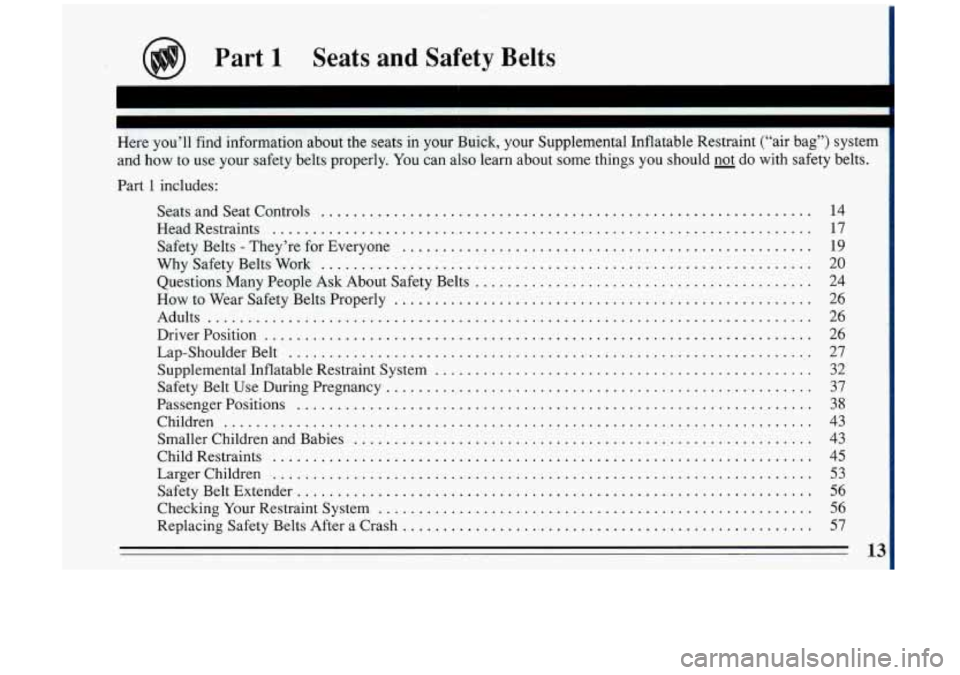
Part 1 Seats and Safety Belts
Here you’ll find information about the seats 111 yuul UUIUS. your Supplemental Inflatable Restraint (“air bag”) systeil\
l
and how to use your safety belts properly
. You can also learn about some things you should @ do with safety belts .
Part 1 includes:
SeatsandSeatControls
............................................................. 14
HeadRestraints
................................................................... 17
WhySafetyBeltsWork ............................................................. 20
Questions Many People Ask About Safety Belts
.......................................... 24
How to Wear Safety Belts Properly
.................................................... 26
Adults
........................................................................\
.... 26
DriverPosition
.................................................................... 26
Lap-ShoulderBelt
................................................................. 27
Supplemental Inflatable Restraint System
............................................... 32
Safety Belt Use During Pregnancy
..................................................... 37
PassengerPositions
................................................................ 38
Children ........................................................................\
. 43
Smaller Children and Babies
......................................................... 43
ChildRestraints
................................................................... 45
LargerChildren
.................................................................... 53
SafetyBeltExtender
................................................................ 56
Checking Your Restraint System
...................................................... 56
Replacing Safety Belts After a Crash
................................................... 57
Safety Belts
. They’re
for Everyone ................................................... 19
Page 16 of 324
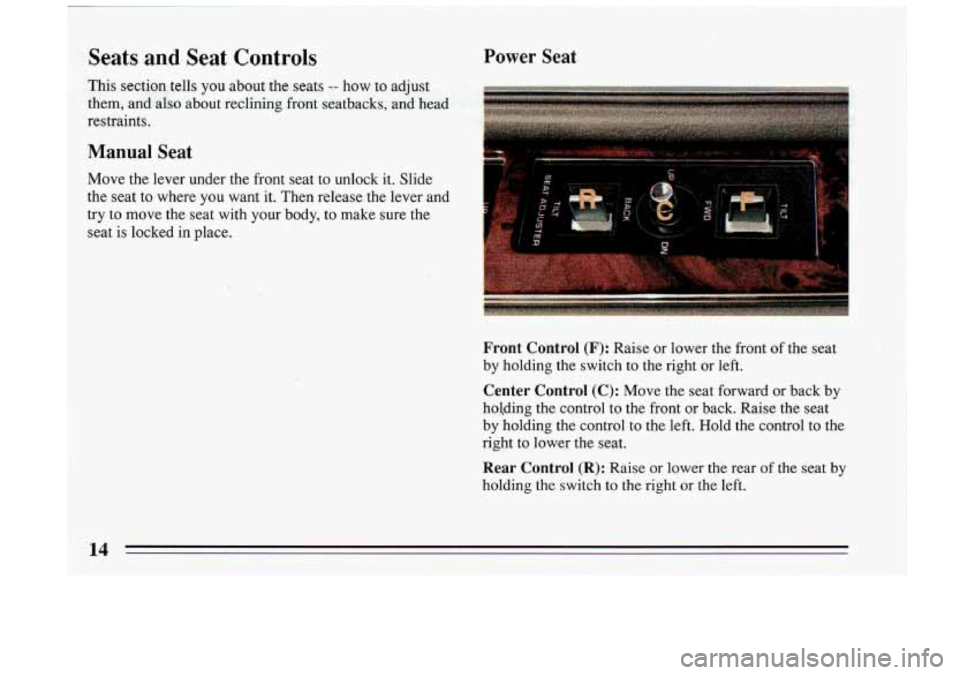
Seats and Seat Controls Power Seat
Front Control (F): Raise or lower the front of the seat
by holding the switch
to the right or left.
Center Control (C): Move the seat forward or back by
holding the control to the front or back. Raise the seat
by holding the control to the left. Hold the control to the
right to lower the seat.
Rear Control (R): Raise or lower the rear of the seat by
holding the switch to the right or the left.
Page 17 of 324
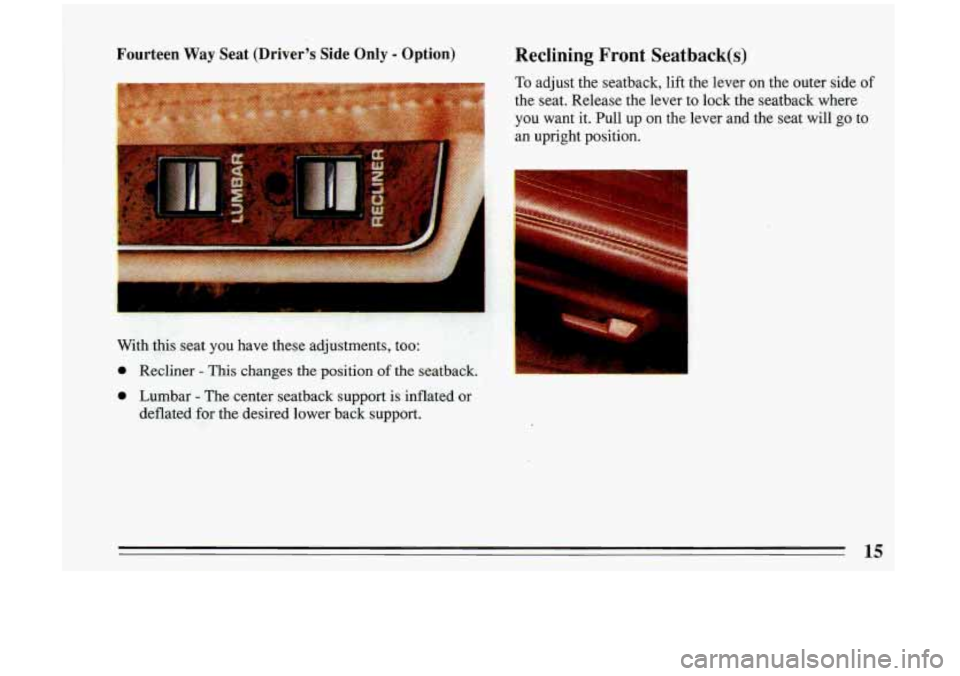
Fourteen Way Seat (Driver’s Side Only - Option) Reclining Front Seatback(s)
To adjust the seatback, lift the lever on the outer side of
the seat. Release the lever to lock the seatback where
an upright position.
I t you want it. Pull up on the lever and the seat will go to
With
this seat you have these adjustments, too:
0 Recliner - This changes the position of the seatback.
0 Lumbar - The center seatback support is inflated or
deflated for the desired lower back support.
15
Page 18 of 324
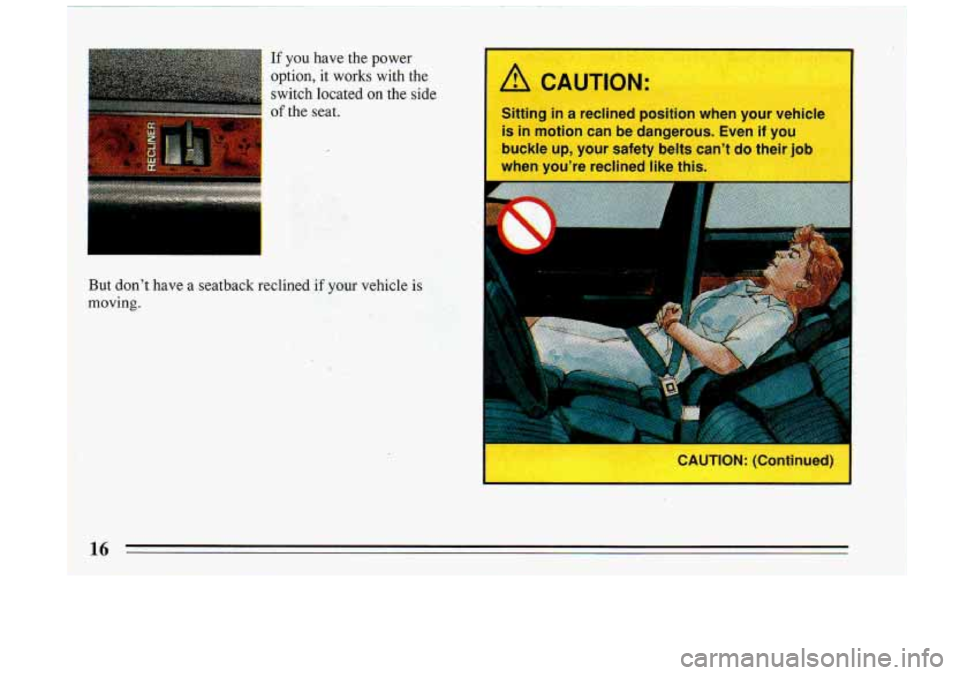
If you have the power
option, it works with the switch located
on the side
of the seat.
But don’t have a seatback reclined
if your vehicle is
moving.
A CAUTION:
Sitting in a reclined position when your vet
I
rn
le
is in motion can be dangerous. Even
if you
buckle up, your safety belts can’t
do their job
when you’re reclined like this.
CAUTION: (Continued)
16
Page 19 of 324
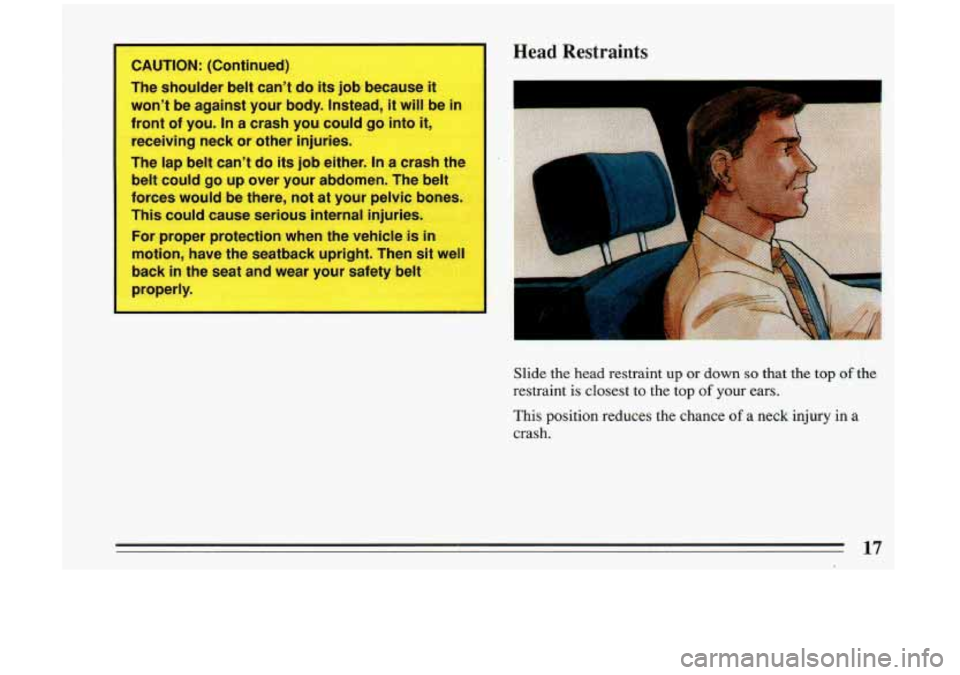
-
I CAUTION: (Continued)
The shoulder belt can't do its job because it
won't be against your body. Instead, it will be in
front of you. In
a crash you could go into it,
receiving neck or other injuries.
The lap belt can't do its job either. In a crash the
belt could go up over your abdomen. The belt
forces would be there, not at your pelvic bones.
This could cause serious internal injuries.
I
For proper protection when the vehicle is
motion, have the seatback upright. Then
back
in the seat and wear your safety belt
I Head Restraints
I properly. m
Slide the head restraint up or dawn so that &e top ,o$.tha:
restraint is: closest -to tbe top of your ears.
This position reduces the chance of a: ne,& injury m a
crash.
17
Page 20 of 324
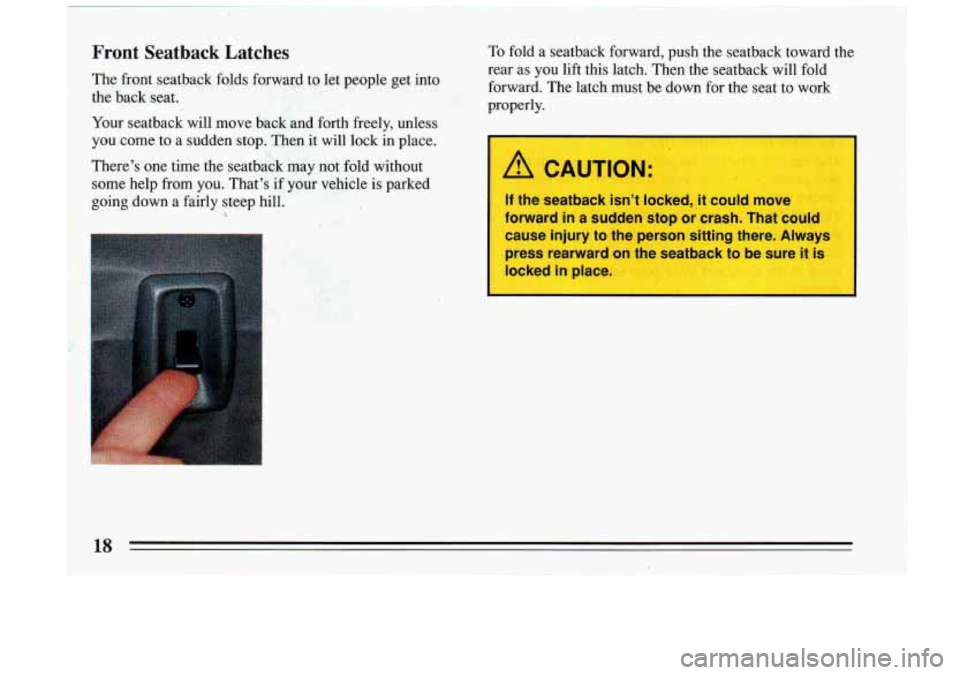
Front Seatback Latches To fold a seatback forward, push the seatback toward the
Your seatback will move back and forth freely, unless
you come
to a sudden stop. Then it will lock in place. =
There's one time the seatback may not fold without
some help from
you. That's if your vehicle is parked
I going down a fairly steep b hill. I
1 A CAUTION:
' If the seatback isn't locked, it could move
forward in a sudden stop or crash. That
ca ~ 1
cause injury to the person sitting there. Always
press rearward on the seatback to be sure it
is
locked in place.